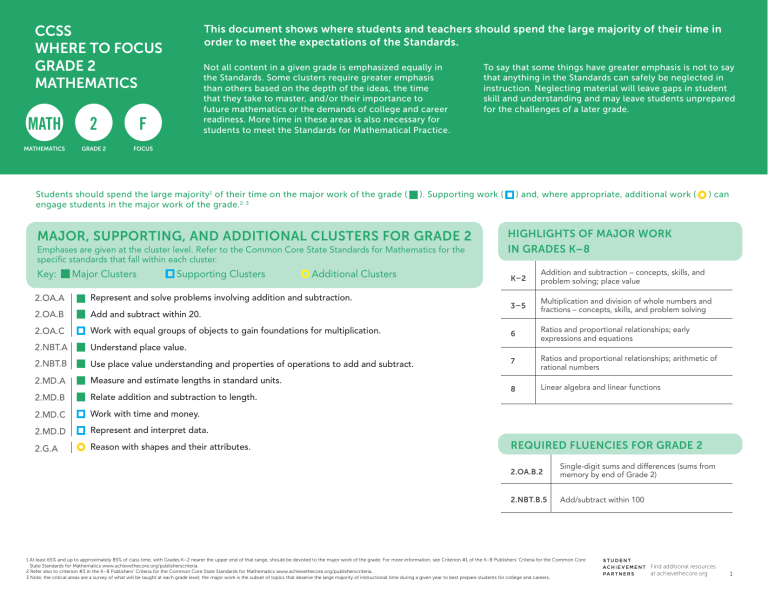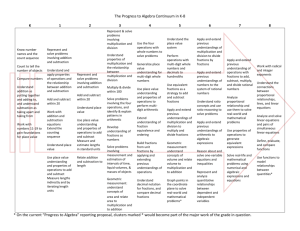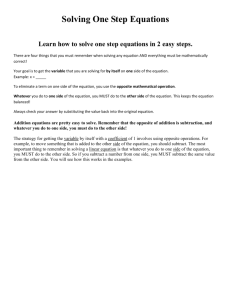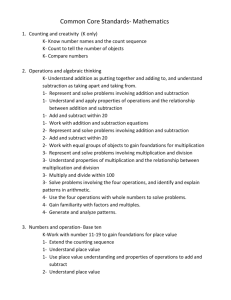MATH 2 F - Achieve the Core

CCSS
WHERE TO FOCUS
GRADE 2
MATHEMATICS
MATH
MATHEMATICS
2
GRADE 2
F
FOCUS
This document shows where students and teachers should spend the large majority of their time in order to meet the expectations of the Standards.
Not all content in a given grade is emphasized equally in the Standards. Some clusters require greater emphasis than others based on the depth of the ideas, the time that they take to master, and/or their importance to future mathematics or the demands of college and career readiness. More time in these areas is also necessary for students to meet the Standards for Mathematical Practice.
To say that some things have greater emphasis is not to say that anything in the Standards can safely be neglected in instruction. Neglecting material will leave gaps in student skill and understanding and may leave students unprepared for the challenges of a later grade.
Students should spend the large majority 1 of their time on the major work of the grade ( ). Supporting work ( ) and, where appropriate, additional work ( ) can engage students in the major work of the grade.
2, 3
MAJOR, SUPPORTING, AND ADDITIONAL CLUSTERS FOR GRADE 2
Emphases are given at the cluster level. Refer to the Common Core State Standards for Mathematics for the specific standards that fall within each cluster.
Key: Major Clusters
2.OA.A
2.OA.B
2.OA.C
2.NBT.A
2.NBT.B
2.MD.A
2.MD.B
2.MD.C
2.MD.D
2.G.A
Supporting Clusters Additional Clusters
Represent and solve problems involving addition and subtraction.
Add and subtract within 20.
Work with equal groups of objects to gain foundations for multiplication.
Understand place value.
Use place value understanding and properties of operations to add and subtract.
Measure and estimate lengths in standard units.
Relate addition and subtraction to length.
Work with time and money.
Represent and interpret data.
Reason with shapes and their attributes.
HIGHLIGHTS OF MAJOR WORK
IN GRADES K–8
K–2
3–5
6
7
8
Addition and subtraction – concepts, skills, and problem solving; place value
Multiplication and division of whole numbers and fractions – concepts, skills, and problem solving
Ratios and proportional relationships; early expressions and equations
Ratios and proportional relationships; arithmetic of rational numbers
Linear algebra and linear functions
REQUIRED FLUENCIES FOR GRADE 2
2.OA.B.2
Single-digit sums and differences (sums from memory by end of Grade 2)
2.NBT.B.5
Add/subtract within 100
1 At least 65% and up to approximately 85% of class time, with Grades K–2 nearer the upper end of that range, should be devoted to the major work of the grade. For more information, see Criterion #1 of the K–8 Publishers’ Criteria for the Common Core
State Standards for Mathematics www.achievethecore.org/publisherscriteria.
2 Refer also to criterion #3 in the K–8 Publishers’ Criteria for the Common Core State Standards for Mathematics www.achievethecore.org/publisherscriteria.
3 Note, the critical areas are a survey of what will be taught at each grade level; the major work is the subset of topics that deserve the large majority of instructional time during a given year to best prepare students for college and careers.
Find additional resources at achievethecore.org
1
CCSS
WHERE TO FOCUS
GRADE 2
MATHEMATICS
An important subset of the major work in grades K–8 is the progression that leads toward middle school algebra.
K 1 2 3 4 5 6 7 8
Know number names and the count sequence
Count to tell the number of objects
Compare numbers
Understand addition as putting together and adding to, and understand subtraction as taking apart and taking from
Work with numbers 11-
19 to gain foundations for place value
Represent and solve problems involving addition and subtraction
Understand and apply properties of operations and the relationship between addition and subtraction
Add and subtract within 20
Work with addition and subtraction equations
Extend the counting sequence
Understand place value
Use place value understanding and properties of operations to add and subtract
Measure lengths indirectly and by iterating length units
Represent and solve problems involving addition and subtraction
Add and subtract within 20
Understand place value
Use place value understanding and properties of operations to add and subtract
Measure and estimate lengths in standard units
Relate addition and subtraction to length
Represent & solve problems involving multiplication and division
Understand properties of multiplication and the relationship between multiplication and division
Multiply & divide within 100
Solve problems involving the four operations, and identify & explain patterns in arithmetic
Develop understanding of fractions as numbers
Solve problems involving measurement and estimation of intervals of time, liquid volumes, & masses of objects
Geometric measurement: understand concepts of area and relate area to multiplication and to addition
Use the four operations with whole numbers to solve problems
Generalize place value understanding for multi-digit whole numbers
Use place value understanding and properties of operations to perform multidigit arithmetic
Extend understanding of fraction equivalence and ordering
Build fractions from unit fractions by applying and extending previous understandings of operations
Understand decimal notation for fractions, and compare decimal fractions
Understand the place value system
Perform operations with multi-digit whole numbers and decimals to hundredths
Use equivalent fractions as a strategy to add and subtract fractions
Apply and extend previous understandings of multiplication and division to multiply and divide fractions
Geometric measurement: understand concepts of volume and relate volume to multiplication and to addition
Graph points in the coordinate plane to solve real-world and mathematical problems*
Apply and extend previous understandings of multiplication and division to divide fractions by fractions
Apply and extend previous understandings of numbers to the system of rational numbers
Understand ratio concepts and use ratio reasoning to solve problems
Apply and extend previous understandings of arithmetic to algebraic expressions
Reason about and solve one-variable equations and inequalities
Represent and analyze quantitative relationships between dependent and independent variables
Apply and extend previous understanding of operations with fractions to add, subtract, multiply, and divide rational numbers
Analyze proportional relationships and use them to solve real-world and mathematical problems
Use properties of operations to generate equivalent expressions
Solve real-life and mathematical problems using numerical and algebraic expressions and equations
Work with radical and integer exponents
Understand the connections between proportional relationships, lines, and linear equations**
Analyze and solve linear equations and pairs of simultaneous linear equations
Define, evaluate, and compare functions
Use functions to model relationships between quantities
* Indicates a cluster that is well thought of as a part of a student’s progress to algebra, but that is currently not designated as major by the assessment consortia in their draft materials. Apart from the one asterisked exception, the clusters listed here are a subset of those designated as major in the assessment consortia’s draft documents.
** Depends on similarity ideas from geometry to show that slope can be defined and then used to show that a linear equation has a graph which is a straight line and conversely.






